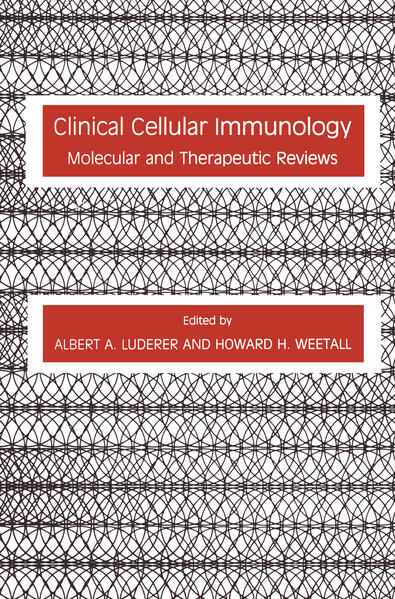
Sofort lieferbar (Download)
Zur Zeit liegt uns keine Inhaltsangabe vor.
Inhaltsverzeichnis
1 The T Cell Antigen Receptor: Structural and Functional Considerations. - 1. Overview. - 2. Functional and Physical Analysis of T Cell Antigen-Specific Receptors. - 3. Serological and Biochemical Analysis of T Cell Antigen-Specific Receptors. - 4. Physiologic Constraints in the Recognition Function of the T Cell Antigen Receptor. - 5. Cytotoxic T Cell Ligand-Binding Sites are Critically Affected by Recognition Structures on Other Cells. - 6. Summary. - References. - 2 Regulation of the Immune Response. - 1. Introduction. - 2. Ir Genes in Guinea Pigs. - 3. The Ir-1 Gene. - 4. Genetic Control of Immune Responsiveness to Staphylococcal Nuclease. - 5. Ia Antigens. - 6. Complementing Ir Genes. - 7. Immunosuppressor Genes. - 8. Genetic Control of Cellular Immune Responses. - 9. Human Immune-Response Genes. - 10. An Hypothesis to Explain the Interrelationship Among Ir Genes, Ia Antigens, and MLR-Stimulating Determinants. - 11. Conclusions. - References. - 3 Immunosuppressive Agents: A Conceptual Overview of Their Action on Inductive and Regulatory Pathways. - 1. Introduction. - 2. Inductive and Regulatory Aspects of Immune Responses: Current Concepts. - 3. Classes and Subclasses of Lymphocytes and Their Functions. - 4. Antibody Responses to Thymus-Independent and Thymus-Dependent Antigens. - 5. Inductive and Regulatory Functions: Antigens, Cells, Cognitive and Regulating Molecules, and Networks. - 6. A Closer Look at Induction and Regulation of Cell-Mediated Immunity. - Acknowledgments. - References. - 4 Immunosuppressive Agents Their Action on Inductive and Regulatory Pathways: The Differential Effects of Agents Used Clinically or Experimentally in the Treatment of Cancer. - 1. Variables that Determine the Effect of Cancer Therapeutic Agents on Antibody Production. - 2. Diversity of Effects ofImmunosuppressive Drugs on CMI. - 3. Alkylating Agents Exert Selective Action Against Cells in the Suppressor Pathway. - 4. A Closer Look at Agents That Are More Suppressive Before Immunization. - 5. The Many Faces and Interfaces of Cyclophosphamide Action. - Acknowledgments. - References. - 5 The Immunobiology of Human Non-Hodgkin s Lymphomas. - 1. Introduction. - 2. Classification Schema. - 3. Functional Studies. - 4. The Ontogeny of Lymphocytes. - 5. Overview of Immunoregulation. - 6. Lymphocyte Identification. - 7. New Directions. - Acknowledgments. - References. - 6 Cell-Mediated Immunity in Autoimmune Disease. - 1. Introduction. - 2. Self-Recognition and Tolerance. - 3. Induction of Autoimmunity. - 4. Pathogenic Mechanisms in Autoimmune Disease. - 5. Cell-Mediated Immunity in Autoimmune Diseases of Animals. - 6. Cell-Mediated Immunity in Autoimmune Disease of Humans. - 7. Summary. - References. - 7 Cell-Mediated Immunity in Tumor Rejection. - 1. Immune Surveillance A Theory Under Scrutiny. - 2. Tumor Antigens. - 3. Effector Mechanisms in Cell-Mediated Immunity. - 4. Effector Molecules. - 5. Depression of Immunity by Tumors: Suppressor Cells and Factors. - 6. Immunotherapy. - 7. Conclusions. - References. - 8 Transfer Factor and Other Factors in Leukocyte Dialyzates That Affect Cell-Mediated Immunity. - 1. Introduction. - 2. The Transfer Phenomenon. - 3. Clinical Use of Leukocyte Dialyzates or Transfer-Factor Preparations. - 4. Biochemical Characterization. - 5. Experimental Considerations. - 6. Implications for Immunotherapy. - References. - 9 Hybridization of Lymphocytes: Techniques and Applications. - 1. Introduction. - 2. B Cell Hybrids. - 3. T Cell Hybrids. - 4. Applications and Future Perspectives. - Notes Added in Proof. - Acknowledgment. - References. - 10 Immunologic Tests for Diagnosis andMonitoring of Defects in Cell-Mediated Immunity. - 1. Introduction. - 2. Anatomy of the Immune System. - 3. In Vivo Manifestations of Cell-Mediated Immunity. - 4. In Vitro Tests of Cell-Mediated Immunity. - 5. Clinical Immunodeficiencies. - 6. Conclusion. - Acknowledgments. - References.
Produktdetails
Erscheinungsdatum
06. Dezember 2012
Sprache
englisch
Seitenanzahl
392
Dateigröße
25,96 MB
Reihe
Contemporary Immunology
Autor/Autorin
Albert A. Luderer, Howard H. Weetall
Verlag/Hersteller
Kopierschutz
mit Wasserzeichen versehen
Produktart
EBOOK
Dateiformat
PDF
ISBN
9781461258025
Entdecken Sie mehr
Bewertungen
0 Bewertungen
Es wurden noch keine Bewertungen abgegeben. Schreiben Sie die erste Bewertung zu "Clinical Cellular Immunology" und helfen Sie damit anderen bei der Kaufentscheidung.








